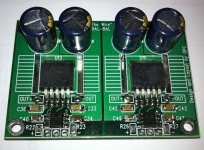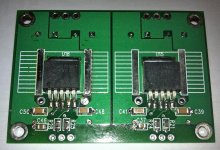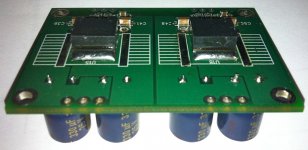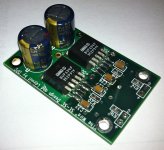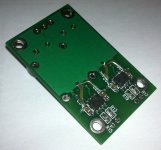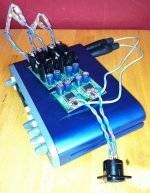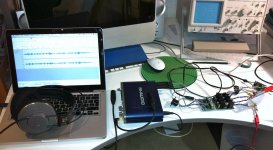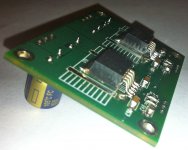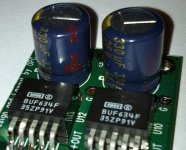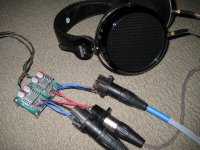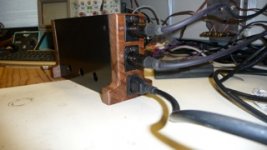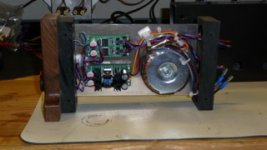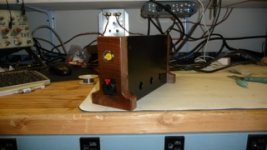Personally I think any DC coupled head amp needs a muting relay that monitors the DC on the output, even better if it monitors the rails (on a split supply.) And even that isn't a fail-safe guarantee, a fuse on the mains isn't going to give much protection for the headphones, if you have the transformer sized right and want a fuse lower than its VA rating, you're looking at a slo-blow to survive the inrush. And the slo-blow fuse probably has killed more headphones than anything 
I use AT's for a cheap sub after building a dc-coupled amp for a month before I casually plug in expensive Grados, and I know for an unfortunatly for a fact that 80mV of DC-offset will burn the voice coil. If you have ever looked at how small the coil make up is they just can't take the heat from DC offset.
Granted a LME49600 failure is much less likely than discrete output stage and probably much less risk, but with expensive headphone I think a muting relay is needed, even though it can hurt the noise-floor. Alternatively what RS did with the O2 seems to work without the noise penalty, but I stumbled on a failure mode with it that gives high offset on the output.
But folks building the wire, need to know that murphy's law still applies here and I think DC protection on the output should be SOP.
I use AT's for a cheap sub after building a dc-coupled amp for a month before I casually plug in expensive Grados, and I know for an unfortunatly for a fact that 80mV of DC-offset will burn the voice coil. If you have ever looked at how small the coil make up is they just can't take the heat from DC offset.
Granted a LME49600 failure is much less likely than discrete output stage and probably much less risk, but with expensive headphone I think a muting relay is needed, even though it can hurt the noise-floor. Alternatively what RS did with the O2 seems to work without the noise penalty, but I stumbled on a failure mode with it that gives high offset on the output.
But folks building the wire, need to know that murphy's law still applies here and I think DC protection on the output should be SOP.
I might want to combine 'the wire' headphone amp with a usb dac. I'd like to switch between the inputs of the 'wire' and the dac. I guess I can do that with a simple DPDT switch.
If I were to do this, I guess I can bypass the output of the dac and feed it directly into the 'wire'?
If I were to do this, I guess I can bypass the output of the dac and feed it directly into the 'wire'?
Two PSU modules were hooked up to another BAL-BAL with an M-Audio FastTrack Pro as a balanced source (mediocre choice, but mobile).
First pic also reveals the common AC/DC input wiring in the background and the 4-pin XLR connector in the foreground.
I even had the opportunity to have a couple of friends (one tube lover, one Stax owner) take a shot at listening to my balanced AKG K501, a custom Beyerdynamic DT770 and some other cans through both of THE WIREs either.
Second pic shows the K501 (disconnected) with the balanced wire mod, the accompanying balanced-to-unbalanced adaptor and the two WIREs. In the background (far right) there's an SE-SE that was tested via the single ended outputs of the audio interface.
First pic also reveals the common AC/DC input wiring in the background and the 4-pin XLR connector in the foreground.
I even had the opportunity to have a couple of friends (one tube lover, one Stax owner) take a shot at listening to my balanced AKG K501, a custom Beyerdynamic DT770 and some other cans through both of THE WIREs either.
Second pic shows the K501 (disconnected) with the balanced wire mod, the accompanying balanced-to-unbalanced adaptor and the two WIREs. In the background (far right) there's an SE-SE that was tested via the single ended outputs of the audio interface.
Attachments
And here's one of the SE-SE rework boards, reworked of course:
Very nice! Is that a touch of sacrificial blood atop the Se-Se?... the Audio Gods will be pleased if it is
Some additional details:
The Sanyo capacitors were right in my shopping basket at DigiKey. On my way to the checkout someone apparently bought all their stock, two weeks lead time. Bummer!
I went for Panasonic FC, can't complain.
Soldering the TO-263 devices was easier than I feared. Soldering the Aavid heat sinks was virtually impossible. I decided to leave them out for now, will see if I need them in the future. A hot air nozzle tip on a gas soldering iron will help.
If you look closely, you can see that I applied thermal grease underneath the buffers. It's visible underneath the pins and on the side of the farther buffer.
Next time I do six SMD boards, I'll reflow solder them.
The Sanyo capacitors were right in my shopping basket at DigiKey. On my way to the checkout someone apparently bought all their stock, two weeks lead time. Bummer!
I went for Panasonic FC, can't complain.
Soldering the TO-263 devices was easier than I feared. Soldering the Aavid heat sinks was virtually impossible. I decided to leave them out for now, will see if I need them in the future. A hot air nozzle tip on a gas soldering iron will help.
If you look closely, you can see that I applied thermal grease underneath the buffers. It's visible underneath the pins and on the side of the farther buffer.
Next time I do six SMD boards, I'll reflow solder them.

Attachments
Very nice! Is that a touch of sacrificial blood atop the Se-Se?... the Audio Gods will be pleased if it is
Haha, well spotted. I'd like to claim Audio God Karma points out of this project, as it was really demanding on the eyes, but fortunately Matsushita/Panasonic took care of coloring their capacitors all by themselves.
The attached picture reveals another peculiarity of my build: BUF634.
I didn't happen to have twelve LME49600 at hand.
So I alternated between LME49600, LME49610 and BUF634 throughout the boards.
As of yet I still have to determine the possible sonic differences between the three buffer types. Heck, on one of the SE-SE I even had to mix LME49600 and LME49610.
Attachments
Hi sek,
Excellent work! They look great. Any problems or issues with the build or was it smooth sailing?
Any listening impressions? What did your tube/Stax friends think?
I would be curious to see if you can tell the difference between the BUF and the LME parts. I see that you managed to get a full compliment of 49600 on the BAL-BAL which is good!
I've attached a picture of my current headphone setup. I managed to get a pair of HE-6 headphones on loan for a few weeks, and these things are absolute pigs when it comes to power requirements. I can plug in my Denons, set the level such that it's just on the limit of what I'm comfortable with, then swap to the HE-6 and the music is barely audible!
I upped the gain to allow for full voltage swing with 2VRMS on the input, and I think that was a little bit of an overcompensation since it's a bit too much drive and I can't run with the volume full out. Good news is this amp is more than happy to drive the worlds least efficient current production headphones to ear splitting levels!
I'm still trying to decide if I like the HE-6 phones overall. They do some things extremely well, but they have a few peculiarities with the sound that I'm still getting used to.
Cheers,
Owen
Excellent work! They look great. Any problems or issues with the build or was it smooth sailing?
Any listening impressions? What did your tube/Stax friends think?
I would be curious to see if you can tell the difference between the BUF and the LME parts. I see that you managed to get a full compliment of 49600 on the BAL-BAL which is good!
I've attached a picture of my current headphone setup. I managed to get a pair of HE-6 headphones on loan for a few weeks, and these things are absolute pigs when it comes to power requirements. I can plug in my Denons, set the level such that it's just on the limit of what I'm comfortable with, then swap to the HE-6 and the music is barely audible!
I upped the gain to allow for full voltage swing with 2VRMS on the input, and I think that was a little bit of an overcompensation since it's a bit too much drive and I can't run with the volume full out. Good news is this amp is more than happy to drive the worlds least efficient current production headphones to ear splitting levels!
I'm still trying to decide if I like the HE-6 phones overall. They do some things extremely well, but they have a few peculiarities with the sound that I'm still getting used to.
Cheers,
Owen
Attachments
nice work sek! how are the buffers coping with just grease?
hey opc: yeah i agree about the HE6, theres something a bit odd about the soundstage to my ears and a weird tonality around hmm 400-500hz maybe from memory. uncomfortable as hell, heavy. i didnt find them natural, maybe i didnt have the right amp or source material to make them shine, it was at a meet; but it didnt leave me wanting a set. To me while i found them reasonably open, there was just something that seemed a bit restricted
hey opc: yeah i agree about the HE6, theres something a bit odd about the soundstage to my ears and a weird tonality around hmm 400-500hz maybe from memory. uncomfortable as hell, heavy. i didnt find them natural, maybe i didnt have the right amp or source material to make them shine, it was at a meet; but it didnt leave me wanting a set. To me while i found them reasonably open, there was just something that seemed a bit restricted
Hi Owen,
thanks for the kind words.
I'd like to split up my response in order not to degrade readability.
Basically, yes, very streamlined process, just following the build wiki.
All the components fit as specified, the recommended order of placement in the wiki helps attempting the placement.
Despite the fact that DigiKey managed to send me only 11 of the 20 1uF 0805 caps, but still labeled and charged for the intended 20, which I had to substitute for 1206 parts, all went well.
It was a lot of fun soldering them by hand, even though reflow soldering them would make sense, too. I also wish I had thought of chemically/mechanically cleaning the HAL surface first.
For hand soldering the PSU's bridge diodes are a little close together. Here's my recommendation of how to approach them:
Using a flat tip iron of moderate power, apply solder to the underside of one (!) of each diode's pad. Then start placing them by going with one bridge first, then the second one. The first pads to solder should be those where the SMA devices come together back to back, i.e. where D2 and D3 (or D4/D5, D7/D8, D9/D10, respectively) share a common signal. Once all of them are soldered down on one of their pads, go around the diode array and solder the residual pads, carefully avoiding to touch the cases with your iron.
I had one diode pair soldered together, but not successfully connected to their pads, which made this regulator not start up at first.
Contrary to widespread belief, it is not recommended to use a weak soldering iron (i.e. just because the SMT components are small).
Instead, soldering most components onto large area copper planes requires sufficient power for the solder to flow.
thanks for the kind words.
I'd like to split up my response in order not to degrade readability.
Any problems or issues with the build or was it smooth sailing?
Basically, yes, very streamlined process, just following the build wiki.
All the components fit as specified, the recommended order of placement in the wiki helps attempting the placement.
Despite the fact that DigiKey managed to send me only 11 of the 20 1uF 0805 caps, but still labeled and charged for the intended 20, which I had to substitute for 1206 parts, all went well.
It was a lot of fun soldering them by hand, even though reflow soldering them would make sense, too. I also wish I had thought of chemically/mechanically cleaning the HAL surface first.
For hand soldering the PSU's bridge diodes are a little close together. Here's my recommendation of how to approach them:
Using a flat tip iron of moderate power, apply solder to the underside of one (!) of each diode's pad. Then start placing them by going with one bridge first, then the second one. The first pads to solder should be those where the SMA devices come together back to back, i.e. where D2 and D3 (or D4/D5, D7/D8, D9/D10, respectively) share a common signal. Once all of them are soldered down on one of their pads, go around the diode array and solder the residual pads, carefully avoiding to touch the cases with your iron.
I had one diode pair soldered together, but not successfully connected to their pads, which made this regulator not start up at first.
Contrary to widespread belief, it is not recommended to use a weak soldering iron (i.e. just because the SMT components are small).
Instead, soldering most components onto large area copper planes requires sufficient power for the solder to flow.
Any listening impressions? What did your tube/Stax friends think?
A couple of impressions actually.
After my stability and offset measurements and some initial checking out of some sources and some music, my wife was the first one to carefully listen.
After wiping away some tears of joy she demanded a mobile version for herself. I then didn't hear from her until late in the evening, it turned out she tried all our ear- and headphones on the SE-SE.
At my friend's place I used his lab supplies in order to supply both the SE-SE and the PSU boards. We then used the pictured computer and audio interface for 24/96 playback, as well as iPod (Classic) and iPhone (4) for uncompressed CD material.
The one friend with the tube equipment actually builds it himself (as well as his speakers), so he had more of a DIY inclination to it. He mainly commented about noise, clarity and drive capability. His verdict was positive on all accounts.
The other friend with the long-term Stax history considers himself a music consumer, not a DIYer. He commented on subjective impressions, wideness of soundstage (admittedly one of the K501's strengths), clarity of instruments and wideness of the room (whatever that means inbetween headphone drivers
After some careful listening he concluded that this was his first time to actually find dynamic headphones acceptable. His subtle remark: "You're on the right track with this."
I would be curious to see if you can tell the difference between the BUF and the LME parts. I see that you managed to get a full compliment of 49600 on the BAL-BAL which is good!
I didn't get around to comparing them as of yet. Only the SE-SE with the mixed buffers (LME49600/LME49610) and the BAL-BAL with the LME49610 are hooked up for now. But of course the BAL-BALs are both equipped with four identical buffer types each.
I've attached a picture of my current headphone setup. I managed to get a pair of HE-6 headphones on loan for a few weeks, and these things are absolute pigs when it comes to power requirements. I can plug in my Denons, set the level such that it's just on the limit of what I'm comfortable with, then swap to the HE-6 and the music is barely audible!
We've also made this experience with our sources. The audio interface got louder than the mobile players, but actually managed to drive it's own outputs into clipping!
I upped the gain to allow for full voltage swing with 2VRMS on the input, and I think that was a little bit of an overcompensation since it's a bit too much drive and I can't run with the volume full out. Good news is this amp is more than happy to drive the worlds least efficient current production headphones to ear splitting levels!
That's something I wanted to discuss anyway: different gain settings and impedance levels on THE WIRE.
Lowering the input impedance is probably not a good idea with regards to source compatibility.
Then again even National recommend the circuit topology with a gain of 10, i.e. Rf/Rg = 10k/1k in a circuit example.
How low would you choose Rg, how much gain would you recommend with respect to noise performance and stability?
Cheers,
Sebastian.
Last edited:
Hi qusp,
thanks for the heads up.
Surprisingly well actually. I had the idea after attempting the first SE-SE board. I didn't want to risk the buffers by going at them with a more powerful iron, so I thought ... why not. It should be mentioned that the protruding edges of the buffers' tabs are all properly soldered to the PCB pads, though.
The thermal compound I used is of rather high viscosity, it doesn't flow on it's own. I'm surprised it sustained the heat and the washing (with IPA).
During our listening tests we measured the TO-263 surface and the PCB temperature using an IR thermometer. The buffers never climbed significantly above 41°C, the gradient between buffers and board was never larger than 2-3°C.
thanks for the heads up.
how are the buffers coping with just grease?
Surprisingly well actually. I had the idea after attempting the first SE-SE board. I didn't want to risk the buffers by going at them with a more powerful iron, so I thought ... why not. It should be mentioned that the protruding edges of the buffers' tabs are all properly soldered to the PCB pads, though.
The thermal compound I used is of rather high viscosity, it doesn't flow on it's own. I'm surprised it sustained the heat and the washing (with IPA).
During our listening tests we measured the TO-263 surface and the PCB temperature using an IR thermometer. The buffers never climbed significantly above 41°C, the gradient between buffers and board was never larger than 2-3°C.
- Status
- This old topic is closed. If you want to reopen this topic, contact a moderator using the "Report Post" button.
- Home
- Amplifiers
- Headphone Systems
- THE WIRE conglomerate build thread, impressions and gallery
